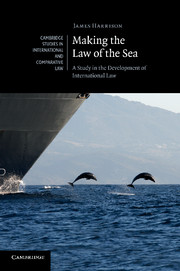Book contents
- Frontmatter
- Contents
- Acknowledgements
- Table of treaties
- Table of cases
- Abbreviations
- 1 Making the modern law of the sea: challenges and opportunities
- 2 The United Nations Convention on the Law of the Sea
- 3 Amendment and modification of the Law of the Sea Convention by the States Parties
- 4 Implementing agreements
- 5 Developments in the deep seabed mining regime
- 6 The International Maritime Organization and the international regulation of shipping
- 7 The contribution of the Food and Agriculture Organization to international fisheries law
- 8 Cooperation, coordination and conflict between international institutions
- 9 Conclusion
- Bibliography
- Index
- CAMBRIDGE STUDIES IN INTERNATIONAL AND COMPARATIVE LAW
5 - Developments in the deep seabed mining regime
Published online by Cambridge University Press: 03 May 2011
- Frontmatter
- Contents
- Acknowledgements
- Table of treaties
- Table of cases
- Abbreviations
- 1 Making the modern law of the sea: challenges and opportunities
- 2 The United Nations Convention on the Law of the Sea
- 3 Amendment and modification of the Law of the Sea Convention by the States Parties
- 4 Implementing agreements
- 5 Developments in the deep seabed mining regime
- 6 The International Maritime Organization and the international regulation of shipping
- 7 The contribution of the Food and Agriculture Organization to international fisheries law
- 8 Cooperation, coordination and conflict between international institutions
- 9 Conclusion
- Bibliography
- Index
- CAMBRIDGE STUDIES IN INTERNATIONAL AND COMPARATIVE LAW
Summary
Marine minerals and the International Seabed Area
Although the presence of minerals on the deep seabed was first discovered on the HMS Challenger expedition in 1873, it was not until the latter half of the twentieth century that their exploitation became technologically feasible. The regulation of deep seabed mining was addressed for the first time by the UN Seabed Committee and thereafter by delegates gathering at UNCLOS III to negotiate a new convention on the law of the sea. It was the issue that proved to be the most divisive at the Conference and despite protracted negotiations, participants were unable to achieve a compromise. However, further consultations taking place under the auspices of the United Nations Secretary-General succeeded where UNCLOS III had failed. When the Law of the Sea Convention finally entered into force in November 1994, the international regime for the deep seabed found in Part XI of the Convention was substantially modified by the Part XI Agreement that had been adopted by the UN General Assembly in July of that year. It is these two instruments that today provide the framework for the management of the International Seabed Area.
Under Part XI of the Law of the Sea Convention, the Area is designated as the common heritage of mankind and it is managed on behalf of the international community as a whole by an international organization called the International Seabed Authority.
- Type
- Chapter
- Information
- Making the Law of the SeaA Study in the Development of International Law, pp. 115 - 153Publisher: Cambridge University PressPrint publication year: 2011

